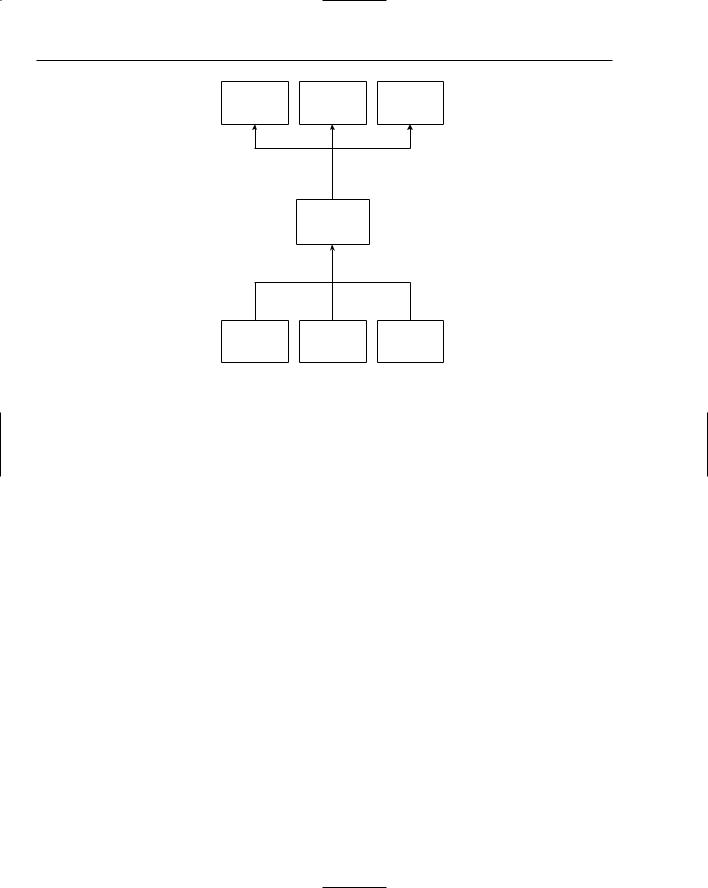
Professional Java.JDK.5.Edition (Wrox)
.pdf
Contents
Utilizing RowSets |
308 |
Understanding RowSet Events |
308 |
RowSet Standard Implementations |
308 |
Using the New JdbcRowSetImpl |
309 |
Connection Pooling |
310 |
Managing Transactions |
310 |
What Is a Transaction? |
310 |
Standard Transactions |
311 |
Distributed Transactions |
311 |
Object to Relational Mapping with Hibernate |
312 |
Exploring Hibernate’s Architecture |
312 |
Supported Database Platforms |
314 |
Plugging Hibernate In |
314 |
Developing with Hibernate |
315 |
Understanding Mappings |
315 |
Setting Hibernate Properties |
317 |
Using Hibernate’s APIs for Persistence |
317 |
Putting It All Together: The Forum Example |
320 |
Summary |
327 |
Chapter 7: Developing Web Applications Using the Model 1 Architecture |
329 |
What Is Model 1? Why Use It? |
329 |
JSP 2.0 Overview |
331 |
Servlet 2.4 Support |
332 |
Expression Language Support |
332 |
Code Reuse with *.tag and *.tagx Files |
335 |
JSP Page Extensions (*.jspx) |
336 |
Simple Invocation Protocol |
337 |
Integrated Expression Language (EL) |
339 |
JSTL 1.1 Overview |
340 |
Function Tag Library |
341 |
SQL Actions |
342 |
Developing Your Web Application Visualizations with JSTL |
344 |
Developing Your Web Application Visualizations with JSP 2.0 |
350 |
Summary |
364 |
Chapter 8: Developing Web Applications Using the Model 2 Architecture |
365 |
The Problem |
365 |
What Is Model 2? |
365 |
Why Use Model 2? |
367 |
xviii

|
Contents |
Developing an Application with WebWork |
368 |
What Is Inversion of Control and Why Is It Useful? |
369 |
Architecture |
371 |
Interceptors |
372 |
ValueStack |
373 |
OGNL |
373 |
Components |
374 |
Extending the Framework to Support Hibernate |
374 |
Preventing the Hanging Session |
375 |
Defining Your Domain Model |
378 |
Implementing Your Use Cases with Actions |
384 |
Developing Your Views |
387 |
Adding Contacts to the System |
389 |
Browsing Contacts |
391 |
Configuring Your Application |
394 |
Adapting to Changes |
397 |
Summary |
399 |
Chapter 9: Interacting with C/C++ Using Java Native Interface |
401 |
A First Look at Java Native Interface |
401 |
Creating the Java Code |
402 |
Creating the Native Code and Library |
403 |
Executing the Code |
405 |
Java Native Interface |
406 |
Data Types |
406 |
Strings in JNI |
406 |
String Example |
408 |
Arrays in JNI |
410 |
Array Functions |
411 |
Array Examples |
413 |
Working with Java Objects in C/C++ |
416 |
Accessing Fields in JNI |
416 |
Invoking Java Methods Using JNI |
419 |
Handling Java Exceptions in Native Code |
423 |
Working with Object References in Native Code |
425 |
Local References |
425 |
Global and Weak Global References |
427 |
Comparing References |
429 |
Advanced Programming Using JNI |
429 |
Java Threading |
429 |
Native NIO Support |
430 |
xix

Contents
Manually Registering Native Methods |
430 |
Reflection |
432 |
Developing an E-Mail Client |
434 |
System Design |
434 |
User Interface |
435 |
Summary |
444 |
Chapter 10: Communicating between Java Components with RMI and EJB |
445 |
Remote Method Invocation |
445 |
Exploring RMI’s Architecture |
446 |
Developing RMI Applications |
448 |
Using Threads in RMI |
448 |
Using Dynamic Class Loading |
449 |
Distributed Garbage Collection |
449 |
Examining Remote Object Activations |
449 |
TestRemoteInterface Interface |
450 |
TestActivationImpl Class |
450 |
TestClient Class |
451 |
Register Class |
452 |
Starting the Activation Tools |
453 |
RMIChat Example |
453 |
RMIChat Interface |
454 |
RMIChatImpl Class |
455 |
ChatUser Class |
459 |
ChatApplet Class |
460 |
Compiling the RMIChat Application |
464 |
Enterprise JavaBeans |
465 |
EJB Basics |
465 |
Types of EJBs |
466 |
Session Beans |
466 |
Entity |
466 |
Message Driven |
466 |
Examining EJB Containers |
467 |
EJB Loan Calculator Example |
468 |
LoanObject Interface |
468 |
LoanHome Interface |
468 |
LoanBean Class |
469 |
LoanClient Class |
470 |
Examining the EJB-JAR.XML File |
473 |
Summary |
475 |
xx

|
Contents |
Chapter 11: Communicating between Java Components and |
477 |
Components of Other Platforms |
|
Component Communication Scenarios |
478 |
News Reader: Automated Web Browsing |
478 |
A Bank Application: An EJB/J2EE Client |
478 |
A Portal: Integrating Heterogeneous Data Sources and Services |
478 |
Overview of Interprocess Communication and Basic Network Architecture |
479 |
Sockets |
480 |
The Java Socket API |
481 |
Key Classes |
481 |
Client Programming |
481 |
Server Programming |
482 |
Putting It All Together: An Echo Server |
483 |
Implementing a Protocol |
487 |
Protocol Specification |
488 |
Proprietary Protocols and Reverse Engineering |
498 |
Utilizing Existing Protocols and Implementations |
499 |
Remote Method Invocation |
500 |
Core RPC/RMI Principles |
500 |
Marshalling and Unmarshalling |
501 |
Protocols |
503 |
RMI Registry |
503 |
Distributed Objects |
504 |
Middleware and J2EE |
504 |
Common Object Request Broker Architecture |
505 |
CORBA Basics |
506 |
IDL: Interface Definition Language |
507 |
ORB: Object Request Broker |
509 |
Common Object Service (COS) Naming |
509 |
IIOP: Internet InterORB Protocol |
509 |
RMI-IIOP: Making RMI Compatible with CORBA |
510 |
How to Turn an RMI Object into an RMI-IIOP Object |
510 |
When to Use CORBA |
512 |
Distributed File System Notifications: An Example CORBA System |
513 |
The Implementation |
516 |
Running the Example |
521 |
Web Services |
522 |
Evolution of the World Wide Web |
523 |
Platform Independent RPC |
526 |
Web Services Description Language (WSDL) |
528 |
Simple Object Access Protocol (SOAP) |
529 |
xxi

Contents
Weather Web Site Example |
531 |
The Future |
540 |
Summary |
541 |
Chapter 12: Distributed Processing with JMS and JMX |
543 |
Basic Concepts |
544 |
JMS Fundamentals |
544 |
Sending and Receiving a JMS Message |
545 |
JMX Fundamentals |
548 |
Using Standard MBeans |
549 |
Deploying MBean for Management |
550 |
Using Adaptors and Connectors |
551 |
Building a Distributed Application |
551 |
Deciding on the Message Type |
552 |
Understanding the Three-Component Architecture |
553 |
Creating a Component to Process JMS Messages |
553 |
MessageListener |
555 |
MessageProcessorMBean |
555 |
JndiHelper |
556 |
MessageProcessor |
558 |
Processable |
562 |
OrderProcessor |
562 |
JMXAgent |
563 |
Creating a Component that Directs Messages through the Business Process |
564 |
Routeable |
565 |
MessageRouter |
565 |
Creating a Component to Divide Large Tasks for Parallel Processing |
566 |
Splitable |
567 |
MessageSplitter |
567 |
Aggregateable |
570 |
MessageAggregator |
570 |
OrderAggregator |
572 |
Deploying the Application |
573 |
Basic Deployment |
573 |
Advanced Deployment |
578 |
Deploy the M-Let Service |
579 |
Configure the Deployment Descriptor |
579 |
Add the M-Let Configuration File to the M-Let Service |
581 |
Summary |
581 |
xxii

Contents
Chapter 13: Java Security |
583 |
Java Cryptography Architecture and Java Cryptography Extension (JCA/JCE) |
583 |
JCA Design and Architecture |
584 |
Engine Classes |
584 |
Calculating and Verifying Message Digests |
586 |
Digital Signing and Verification of Data |
588 |
Digital Key Creation and Management |
592 |
Storing and Managing Keys |
596 |
Algorithm Management |
597 |
Random Number Generation |
599 |
Certificate Management |
600 |
Java Cryptography Extension |
602 |
The Cipher Engine Class |
603 |
KeyGenerator |
608 |
SecretKeyFactory |
608 |
Protecting Objects through Sealing |
609 |
Computing Message Authentication Codes |
611 |
Program Security Using JAAS |
612 |
User Identification |
612 |
Executing Code with Security Checks |
613 |
Principals |
614 |
Credentials |
615 |
Authenticating a Subject |
615 |
Configuration |
615 |
LoginContext |
616 |
Authorization |
617 |
Summary |
618 |
Chapter 14: Packaging and Deploying Your Java Applications |
619 |
Examining Java CLASSPATHs |
619 |
Investigating the Endorsed Directory |
624 |
Exploring Java Archives |
625 |
Manipulating JAR files |
625 |
Examining the Basic Manifest File |
628 |
Examining Applets and JARs |
629 |
Signing JAR Files |
630 |
Examining the JAR Index Option |
634 |
Creating an Executable JAR |
635 |
xxiii

Contents
Analyzing Applets |
636 |
Basic Anatomy of an Applet |
636 |
Packaging an Applet for Execution |
638 |
Examining Applet Security |
639 |
Exploring Web Applications |
639 |
Examining the WAR Directory Structure |
640 |
Understanding the WAR Deployment Descriptor |
640 |
Packaging Enterprise Java Beans |
643 |
Inspecting Enterprise Archives |
644 |
The EAR Descriptor File |
644 |
Deployment Scenario |
645 |
Jumping into Java Web Start |
647 |
Examining the TicTacToe Example |
647 |
Examing the TicTacToe.JNLP |
648 |
TTTMain.java |
650 |
TTTLogic.java |
650 |
TTTGui.java |
653 |
Summarizing Java Web Start |
654 |
Using ANT with Web Archives |
654 |
Installing ANT |
654 |
Building Projects with ANT |
655 |
Summary |
659 |
References |
661 |
Index |
663 |
End-User License Agreement |
701 |
xxiv

Introduction
Professional Java, JDK 5 Edition provides a bridge from the “how to” language books that dominate the Java space (Teach Yourself Hello World in Java in 24 Hours) and the more detailed, but technologically stovepiped books on topics such as EJB, J2EE, JMX, JMS, and so on. Most development solutions involve using a mix of technologies, and the books for all of these technologies would stand several feet tall. Furthermore, the reader needs but a fraction of the overall content in these books to solve any specific problems. Professional Java, JDK 5 Edition provides background information on the technology, practical examples of using the technology, and an explanation of where the reader could find more-detailed information. It strives to be a professional reference for the Java developer.
Who This Book Is For
This book serves three types of readers:
The newly introduced reader who has graduated from Beginning Java, by covering moreadvanced Java solutions and language features.
The Java developer who needs a good all-purpose reference and a first source when tackling new Java problems that may be outside their technological experience.
The developer who has already had experience with certain solutions, but may not, for example, think it worthwhile to read 500 pages on JMS alone to see if JMS could fit into their solution space. This book can provide reduced barriers to technological entry for these developers.
What This Book Covers
Professional Java, JDK 5 Edition builds upon Ivor Horton’s Beginning Java 2, JDK 5 Edition by Ivor Horton to provide the reader with an understanding of how professionals use Java to develop software solutions. It starts with a discussion of the tools and techniques of the Java developer, continues with a discussion of the more sophisticated and nuanced parts of the Java SDK, and concludes with several examples of building real Java solutions using Java APIs and open source tools. Professional Java, JDK 5 Edition leaves the reader with a well-rounded survey of the professional Java development landscape, without losing focus in exhaustive coverage of individual APIs. This book is the bridge between Java language texts, methodology books, and specialized Java API books. For example, once you have mastered the basics of the Java language, you will invariably encounter a problem, like building a database-driven Web site, which requires you to use a collection of technologies like JSP, and tools like Hibernate; this book provides a concrete solution that integrates both of them. Figure Intro-1 provides a context to this book’s coverage in relation to other Java books. As you start with the beginning Java books, you would use this book as a solution primer to introduce you to more in-depth books on a particular subject, such as patterns, Web services, or JDBC.

Introduction
Methodology, Patterns, and API Books
Professional
Java
Development
Beginning Java Books
Figure Intro-1
How This Book Is Structured
Working as an effective professional Java developer requires two major skills: thinking like a Java developer and having a broad understanding of Java APIs, tools, and techniques to solve a wide variety of Java problems. Reviewing the structure of the book, you can see how the chapters help you realize the goal of improving these skills.
Thinking Like a Java developer
Experienced Java developers recognize that there is a particular mindset among effective Java developers. The first three chapters provide you with strong coverage of these topics.
Chapter 1: Key Java Language Features and Libraries
Any introductory Java book will cover the features of the Java programming language. This chapter picks up where those books leave off by focusing on a number of the key sophisticated Java language features, such as assertions, regular expression, preferences, and Java logging. Most importantly, this chapter covers a number of key features introduced in the Java 2 Standard Edition 5.0. These include generics, meta data, autoboxing, and more.
Chapter 2: Tools and Techniques for Developing Java Solutions
Making the jump from someone who knows the Java language to a Java developer is an interesting transition. Typically, developers find books that teach the language and books that teach the methodologies. Furthermore, methodology books are often written defensively, as if they are defending a dissertation or prescribing a diet. These books often prescribe ritualistic adherence to their methodology, lest you risk
xxvi

Introduction
failure. New developers can find this approach quite exhausting, since rarely do you start in a position where you can dictate a team’s process. In this book, you will find a developer’s focused view on methodology and tools with practical insights into how to allow tools to make your work easier and more productive.
Chapter 3: Exploiting Patterns in Java
Patterns provide an invaluable resource to developers in trying to communicate solutions to common problems. However, as software problems are generally very abstract, understanding common solutions to them—or even the value of the approach—can be a very overwhelming experience.
However, as you might imagine, there are some key problems that recur throughout the Java solution space, and therefore, frameworks and APIs are built upon patterns. As such, having a utilitarian understanding of patterns is invaluable, and arguably unavoidable in becoming an effective Java developer. This chapter will explain the critical importance of patterns, provide a practical understanding of patterns, and demonstrate examples of common patterns found in the Java world.
A Broad Understanding of Java APIs, Tools, and Techniques
The Java platform has extended beyond being a simple applet development language at its inception to three distinct editions targeted at three different platforms. Not only has the platform evolved into a huge undertaking, but the open source movement and the Java community have also added features and tools that provide even more options to the Java developer.
Therefore, you can find yourself easily overwhelmed. This part of the book provides a series of common problems across the Java development space. In each area, you will be introduced to a problem and a focused solution to that problem. These solutions do not attempt to provide comprehensive coverage of all of the involved APIs but rather a primer needed to solve that problem. From there, you could bridge into a book with more-specialized coverage. The primary intent is to not require a three-foot-tall stack of books to address a simple end-to-end solution to a common development problem.
Chapter 4: Developing Effective User Interfaces with JFC
Commonly referred to simply as Swing, the Java Foundation Classes provide the functionality to build user interfaces and desktop applications. As these classes frequently make up most of the logical examples within introductory Java books, it makes logical sense to start with a Swing example. However, this chapter will cover the intricacies of Swing in more detail, including some advanced topics like Layout Managers and Java 2D.
Chapter 5: Persisting Your Application Using Files
One of the more important things for any application to be able to do is persist its state—that is, save. In this chapter, you will discover techniques to implement save and restore functionality, using two different methods, Java object serialization and the Java API for XML Binding (JAXB).
Chapter 6: Persisting Your Application Using Databases
Files are traditionally used to share data in a single-threaded mode—one user at a time. When data must be shared throughout the enterprise, you use a database. In this chapter, you will learn the more advanced features of the Java Database Connectivity API (JDBC) 3.0, including the new Rowset interface. Furthermore, this chapter will address one of the more popular object persistence frameworks (and the foundation for the development of the new EJB 3.0 specification)—Hibernate.
xxvii
